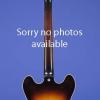A Rare, Totally Mint, Sparkling Burgundy EB-2-C
One of a very few guitars with the rare special "Sparkling Burgundy" factory finish. This super-playing bass weighs just 9.30 lbs. and has a nice narrow nut width of just over 1 1/2 inches and a short scale length of 30 1/2 inches. Laminated maple body, one-piece mahogany neck, and rosewood fretboard with 20 frets and inlaid pearl dot position markers. Headstock with inlaid pearl "Gibson" logo and pearl crown inlay. Two-on-a-side Kluson right-angle tuners with large cloverleaf metal buttons. One very strong "patent number" humbucking pickup with chrome cover and an output of 14.80k. Two controls (one volume, one tone) plus push-button bass boost, all on lower treble bout. Black plastic ribbed-side conical-shape "Witch Hat" knobs. Combined bar bridge/stop tailpiece with mute. The serial number ("949510") is stamped on the back of the headstock and on an oval orange label inside the bass f-hole. There is a tiny amount of finish checking, otherwise this guitar is in mint (9.50) and totally original condition. Housed in the original Gibson black softshell case with velvet lining (9.25).
"Gibson's second electric bass model established a pattern that would hold true for almost all of the company's basses from that date forward. The EB-2 of 1958 was a 'partner' to a similar guitar model -- in this case, the semi-hollow ES-335. The EB-2 was, in effect, an electric bass neck (complete with banjo-style tuners) glued onto the double-cutaway, 'thinline' body of the ES-335. The earliest model had a single-coil pickup with a brown-plastic cover, but this was soon replaced by a large humbucker with a black-plastic cover...A pushbutton 'baritone' (i.e., bass-cut) control was added in 1959, and conventional right-angle tuners replaced the banjo tuners in 1960...The original EB-2 was dropped in 1961 and reintroduced, with a metal pickup cover, in 1964. A double-pickup version, the EB-2D, joined the line in 1966...Both models were discontinued in 1972. Although not commercially successful, Gibson's short-scale, semi-hollow basses -- and such similar models as the Epiphone Rivoli and Guild Starfire Bass -- were popular with many '60s rock bands because they were easy to play and offered different tonal possibilities than Fender basses" (Jim Roberts, American Basses, pp. 73-74).
Translate:

